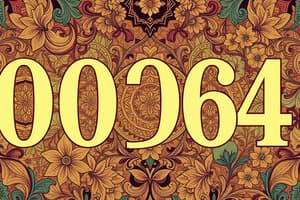Podcast
Questions and Answers
What is the result of converting 583 from base 10 to base 16?
What is the result of converting 583 from base 10 to base 16?
- 1BD
- 2EF
- 36G (correct)
- 4A7
When converting a number from base 10 to base 16, what is involved in the process?
When converting a number from base 10 to base 16, what is involved in the process?
- Multiplying by powers of 16 and adding the remainders (correct)
- Dividing by powers of 16 and adding the remainders
- Adding powers of 16 and multiplying the remainders
- Subtracting powers of 16 and adding the remainders
What is the result of converting 45 from base 10 to base 2 (binary)?
What is the result of converting 45 from base 10 to base 2 (binary)?
- 111010
- 110011
- 101101 (correct)
- 100110
Flashcards are hidden until you start studying
Study Notes
- The text discusses the conversion of decimal numbers to other number systems, specifically base 16 (hexadecimal).
- The speaker uses the example of converting 583 (base 10) to base 16, which results in "36G" (in base 16).
- The speaker describes the process of expanding the base 10 number into base 16, involving powers of 16 and remainders.
- The text also includes an example of converting 45 (base 10) to base 4 (quaternary) and then to base 2 (binary).
- The speaker asks the audience to try converting some numbers to different bases and encourages them to value their mathematics skills.
Studying That Suits You
Use AI to generate personalized quizzes and flashcards to suit your learning preferences.




